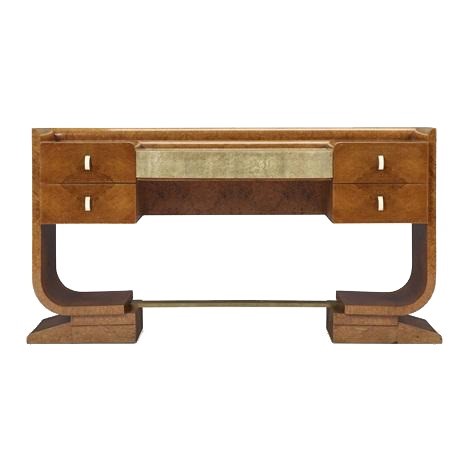Léon-Albert Jallot

(1874-1967)
Although Léon-Albert Jallot was director of Samuel Bing’s Art Nouveau studio from 1899 to 1901 and a founding member of the first exhibition of the Société des Artistes Décorateurs, he was among the first to reject the floral ornamentation of Art Nouveau and adopt a more classical approach committed to puritan linearism. In his opinion, the decorative effect should emerge from the wealth of materials rather than from the wildly proliferating silhouette that only overshadows the real form of an object. As early as 1904, Jallot designed furniture whose only decorative effect was the contrast of wood grain, mother-of-pearl, ivory and ray skin veneer. He remained true to this concept, and his partnership with his son Maurice (since 1928) did not change that.
Over time, Léon Jallot’s aversion to ornamentation was also reflected in his lamp designs. At the Société des Artistes Décorateurs exhibition in 1906, he exhibited chandeliers with cicadas, seahorses and seaweed, but Jallot later rejected these naturalistic motifs in order to turn to indirect lighting. Before that, he and his son had switched entirely to indirect lighting around 1927, delegating the designs for table lamps and chandeliers to specialists such as Perzel, G. Fabre and Eugène Capon.
Maurice Jallot explained their common principles in an article in the magazine >Lux< in 1930: A room is best lit when the light sources are hidden and not visible! As an illustration for this article, you could see the indirectly lit ceiling and the illuminated canopy of the Bielle jewelry store in Algiers. In 1930, Jallot showed fluted columns that were illuminated from within at an exhibition by the Société des Artistes Décorateurs. In 1928, the Jallots designed illuminated pilasters for the Hôtel Radio in Paris that brightened the entire room.
Source: Alastair Duncan, Lampen Lüster Leuchter, Jugendstil Art Déco, Prestel-Verlag, München 1979, 173.


-
RSA Antiquitäten Wiesbaden
-
Taunusstraße 34
65183 Wiesbaden -
+49 611 5 29 05 70
-
+49 170 7 83 01 13
-
info@antiquitaeten-wiesbaden.de
-
Mondayclosed
-
Tuesday - Friday12 a.m. - 6 p.m.
-
Saturday10 a.m. - 4 p.m.